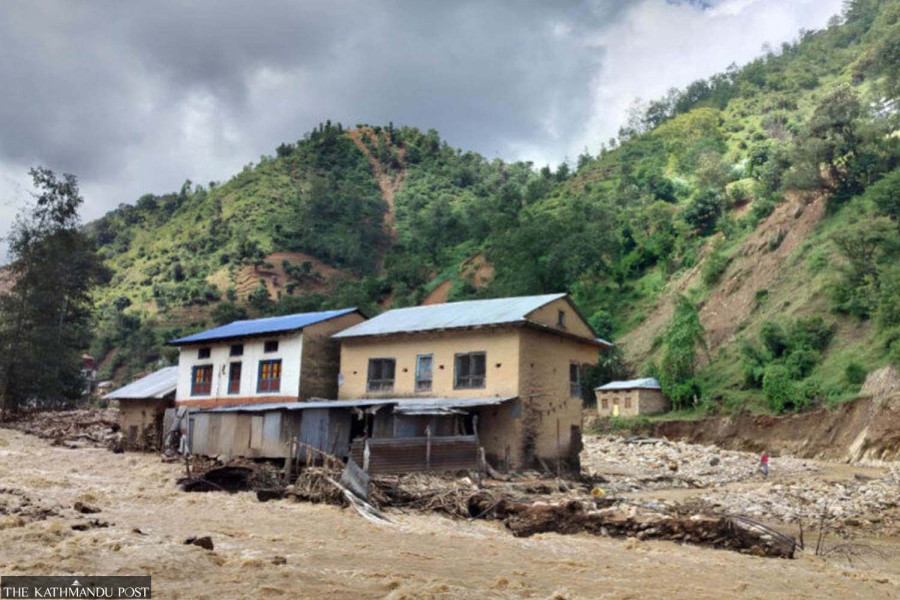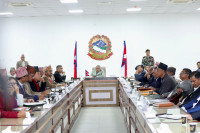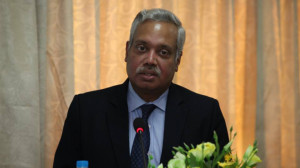National
Climate crisis driving families from Nepal’s mountain, hill villages
Call for action to mitigate climate migration as droughts, floods, lost livelihoods force vulnerable families to leave.
Arjun Poudel
These days, Singha Bahadur Tamang, 66, from ward 5 of Gaurishankar Rural Municipality in Dolakha district, works as a labourer at a road construction site to provide for his family.
He would not have to work as a physical labourer at this age had last monsoon’s landslide not buried his land.
Tamang, a grandfather of five, complained that the families of his two sons left the village and migrated to the district headquarters and Kathmandu following the disaster.
“My family and I would have been busy growing crops had our arable land not been buried by the landslide,” complained Tamang. “I could not stop my children from leaving the village, as they do not see any future here.”
Gaurishankar, a remote rural municipality in northern Nepal bordering Tibet, has been hit hard by the impact of climate change. The problem is not limited to Dolakha but extends to other parts of the country, where extreme weather events—drought and dry spells during the cultivation season and floods and inundation in the harvesting season—have become the new norm over the past few years.
Heavy rainfall in September last year triggered floods and landslides in most parts of the country, causing a loss of Rs46.68 billion to Nepal’s economy.
Also, most parts of the country have not witnessed winter rain for several years, which has affected winter crops and overall agricultural production, and triggered both internal and external migration.
“It is difficult to find people below 60 in the villages,” said Krishna Gopal Thapa, ward 3 chairman of Manthali Municipality in Ramechhap. “Most people have migrated to Kathmandu and other cities, and some have moved to the Middle East.”
Ward 3 residents complain of a severe shortage of drinking water. Of the 765 households in the ward, only 250 have access to clean drinking water.
Nepal has found itself at the receiving end of the climate crisis. Rising temperatures, erratic rainfall, melting glaciers, and extreme weather events have not only affected the environment, but also forced hundreds of thousands of people to leave their homes in search of livelihoods.
“Many homes and settlements have already been deserted,” complained Bhesh Bahadur Khadka, a local resident. “Declining agricultural production, water scarcity, and a lack of jobs have forced most villagers to migrate.”
Environmentalists say that the adverse impacts of climate change have become more visible now with villages turning into ghost settlements, yet authorities have failed to address the crisis.
They say climate-induced migration is becoming a serious issue with profound social and economic implications for the country.
“We hear a lot about sustaining the government but not the people in their villages,” said Madhukar Upadhya, a watershed expert. “Many farmers have been displaced by climate-induced problems—prolonged dry-spells, drought, landslides, flooding and inundation, as well as crop diseases.”
Experts urge authorities to provide immediate relief to affected farmers and introduce adaptation and mitigation programmes.
“Around 200 people die, and properties worth millions are destroyed every year in disaster-related incidents, mainly landslides and floods,” said Manjeet Dhakal, a climate change expert. “The indirect impacts of climate change are also immense in Nepal, and poor communities bear the brunt.”
According to Dhakal, climate-affected people migrate to urban areas, big cities, and foreign countries for livelihoods. However, they remain vulnerable to climate change in new places, as they have to work in excessive heat and live in congested areas.
Despite the growing crisis, officials at the Department of Agriculture admit that they lack comprehensive data on the extent of crop losses caused by erratic weather patterns.
“We have no direct links to local and provincial governments, which may have data on the impact of drought on agricultural production,” said Jagannath Tiwari, the department spokesperson. “There has been no such study.”




 17.12°C Kathmandu
17.12°C Kathmandu















